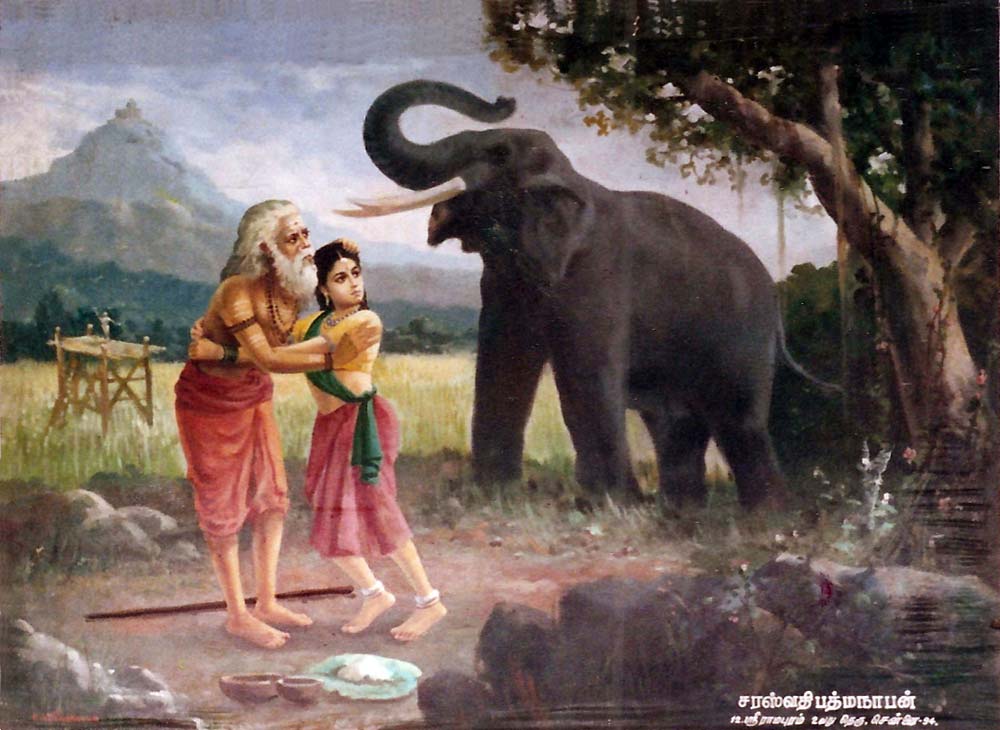
|
|||||||||
|
| |||||||||
Murugan and Valli
Part Three of a three-part series by Kamil V. Zvelebilfrom Tiru Murugan (Madras: International Institute of Tamil Studies, 1981) p. 40-46
ValliFirst then, the name of Valli. The Tamil etymology is a simple and straightforward Dravidian derivation. According to an ancient and persistent tradition, the name of the person is derived from the name of the plant, valli DED 4351, found in Ta. Ma. Ka. Kod. Tu. and Te. and a number of tribal languages. The creeper belongs to the Dioscoreaceae. It has a 'winged' stem, and both wild and cultivated varieties; the cultivated varieties have edible bulbous roots. It is mentioned in the glossary of the 99 plants typical for the kurinci region found in Kurincippattu ascribed to Kapilar (ca. 140-200 AD). In the earliest Tamil texts, the term valli in its meaning of this creeping plant occurs at least 18 times. The Skt. valli, also valli 'creeper, creeping plant' is almost without doubt derived from Dravidian, since the Sanskrit term oc curs relatively late, has no plausible Aryan etymology, and refers to a plant typical for tropical India. In Dravidian, the item is found in relatively 'distant' languages like Tamil and Telugu, and in early records, referring to a plant used almost prehistorical tropical forest cultivation. According to the myth, Valli the person was so called because she was found in a pit dug out while gathering the edible tubers of the valli-plant. Valli as a plant is mentioned in Akam 52.1 and 286.2, Puram 316.9, Nar. 269.7 and Parip. 21.10. The roots (kilanku) of valli are mentioned explicitly in Puc. 109.6 and Kal. 39.12. In Ainkur. 250 a vague but probably significant connection is mentioned between the worship of Murugan and the valli plant. The earliest references to Valli the person, the beloved and consort of Murugan, are relatively few, though increasingly important. In their probable time sequence they are found in Nar. 82.4, Tirumuruk. 102, Parip. 8.69, 9.8, 9.67, 14.22 and Cilap. 24.3. Thus we have all in all only seven relatively early (i.e. pre-bhakti, pre-sixth Cent. AD pre-Pallava) references to Valli as the god's beloved and/or spouse. One of the references belongs to the earliest strata of Tamil texts: Narrinai 82.4. The poem belongs to the kurinci sub-type of akam poetry and may be dated to the 2nd-3rd Cent. AD. It says: niye/ennul varutiyo nalnataik koticci murukupunarntu iyanra valli pola "Oh you, girl of the mountain tribe whose gait is beautiful, will you come to me like Valli who had gladly agreed to join Muruku?" The erotic association is clear: the hero invites the girl to join him as Tamil term punar in murukupuaarntu valli means to reunite, particularly sexually, to cohabit'. It is therefore clear that in the 2nd or 3rd Cent. AD the story of Valli and Murugan -- i.e. the nucleus of the myth narrated above in the sense of Valli being the beloved and sexual partner of Murugan -- was sufficiently well-known to provide a divine model for human behaviour and a material for the poet to draw a simile from. It is worthwhile noticing that at the time when this story was obviously well-known in Tamil India, and hence must have been known there even before the 2nd. Cent., nothing at all is heard yet of a Valli in any Sanskrit or North Indian source. TirumurukarruppataiThe Tirumurukarruppatai is a text qualitatively different from almost all other so-called Sangam poetic texts, not in that it would be much later in time but that it is different in character and purpose. Unlike the other bardic poems, it is a religious text par excellence, a text devoted (for the first time in the development of Tamil textual tradition) exclusively to the worship of a deity -- Murugan. From the point of view of its attitude towards the process broadly termed Sanskritization, Tirumurukarruppatai is certainly integrative and syncretistic. The god's consort Valli is mentioned once as the 'innocent daughter of the mountain-tribe with creeper-like waist, at whom one of the six faces of Murugan smiles in serenity'. Tirumurukarruppatai is also probably the earliest Tamil text which, in agreement with its syncretistic-integrative tendency, mentions for the first time, the northern, imported, consort of Skanda-Murugan -- if not by name than at least by allusion. The term karpu in line 6 of the poem (Skt. kalpaa?) by which Devasena is alluded to means 'fundamental duty, rule, chastity'. It refers to a form of marriage which is according to the rules of the Brahminic order; and indeed Devasena alias Tevayanai has become the symbol of the regular Hindu marriage performed according to Brahminic Hindu rites while Valli, as is clear mainly from the Paripatal, obviously was considered the symbol of kalavu, love-relationship based on katal 'love affection' and of marriage performed according to pre-Aryan, non-Brahminic rites. In fact -- and this is the important conclusion of this talk -- Murugan and Valli are mythic exemplars of the ancient and indigenous Tamil motif of kalavu -- the pre-marital union of lovers. |




